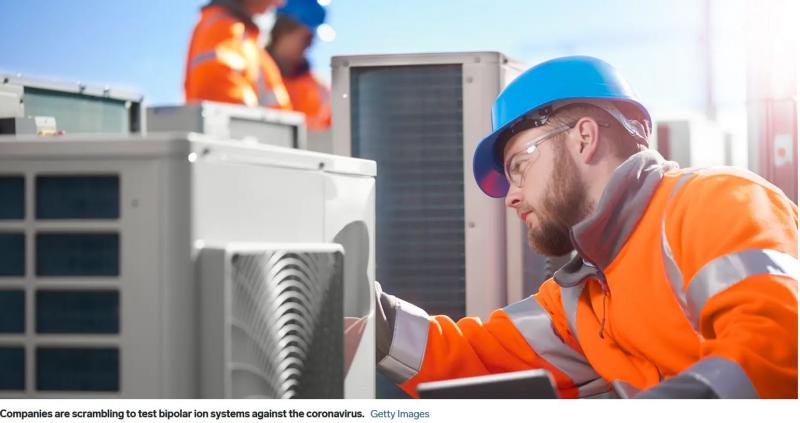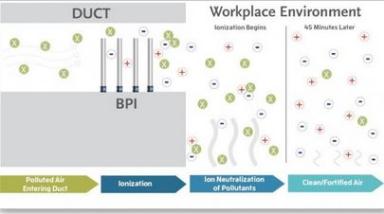Bipolar ionization could be a secret weapon against COVID-19 - Business Insider
Category: News & Politics
Via: sparty-on • 5 years ago • 8 commentsBy: Melanie Haiken (Business Insider)




- Bipolar ionization technology releases charged atoms that attach to and deactivate harmful substances like bacteria, mold, allergens, and viruses.
- It first arrived in the US in the 1970s as a tool to control pathogens in food manufacturing.
- Bipolar ionization has already proven effective against SARS, norovirus, and several influenza strains.
- Visit Business Insider's homepage for more stories.
Bipolar ionization is experiencing a surge in popularity as the coronavirus pandemic fans concerns about air quality.
Integrated into HVAC systems, the technology utilizes specialized tubes that take oxygen molecules from the air and convert them into charged atoms that then cluster around microparticles, surrounding and deactivating harmful substances like airborne mold, bacteria, allergens, and viruses.
They also attach to expelled breath droplets and dust particles that can transport viruses, enlarging them so they're more easily caught in filters. It's an active process that provides continuous disinfection.
"The ions produce a chemical reaction on the cell membrane surface that inactivates the virus," Philip Tierno, a clinical professor of microbiology and pathology at the NYU School of Medicine, told Business Insider. "It can reduce 99.9% of microbes in a matter of minutes."
The battle against the coronavirus could be an air fight
Concerns about airborne transmission have grown as new research indicates the novel coronavirus can remain airborne longer and spread further than previously thought. Some experts now believe that just normal breathing can spread the virus.
"The possibility of aerosolized spread of COVID-19 and the ability of particles to hang in the air for extended periods of time would make the consideration of an active air-cleaning strategy even more prudent," Tierno said.
Long popular in Europe, bipolar ionization first arrived in the US in the 1970s as a tool to control pathogens in food manufacturing. It was effective during the SARS outbreak of 2004, as well as more recent outbreaks of MERS and norovirus and various strains of influenza.
Recent advances have made units cheaper and easier to install and companies are scrambling to test the technology against the coronavirus. According to Tierno, early results have been positive: "Because coronaviruses are enveloped viruses, they are easier to kill compared to naked viruses like noroviruses."
Many large venues already employ bipolar ionization
Hospitals including Johns Hopkins, Children's Hospital Boston and the University of Maryland Medical Center have already embraced the technology.
"Bipolar ionization has been used in healthcare for many years for many applications," Tony Abate, chief technical officer at AtmosAir Solutions, told Business Insider. "We believe bipolar ion systems will become a standard in these critical environments to protect patients and staff.
Los Angeles International Airport is one of more than a dozen travel hubs with AtmosAir systems. FG/Bauer-Griffin/GC Images
Terminals at LaGuardia, O'Hare, LAX, and San Francisco International Airport already have AtmosAir units in place. Tampa's Amalie Arena and the TWA Hotel at JFK airport are adopting bipolar ionization technology, as are large workplaces such as Google's headquarters in Chicago and San Jose.
There are also options for the home, including standalone portable devices and additions to HVAC systems.
"Events like this, unfortunately, act as a wake-up call to understand the implications of not addressing indoor air quality," Larry Sunshine, president of bipolar-ionization company Plasma Air, said. "In the past, improving indoor air quality was oftentimes viewed as a luxury. Now it needs to be viewed as essential."
More:coronavirusoriginal reportingcoronavirus freelanceHVAC

Tags
Who is online
57 visitors

Solutions for a more virus free air environment.
Note: I couldn't get the article photo to work so added a different topic appropriate photo.
We have two systems in our office here............
Nice!
[deleted]
Lol .... the article fairies magically fixed the photo issue.
Such a deal ......
Great seed.
Thanks, i don't think air will be found to be the biggest culprit to Covid-19 spread but every little bit helps